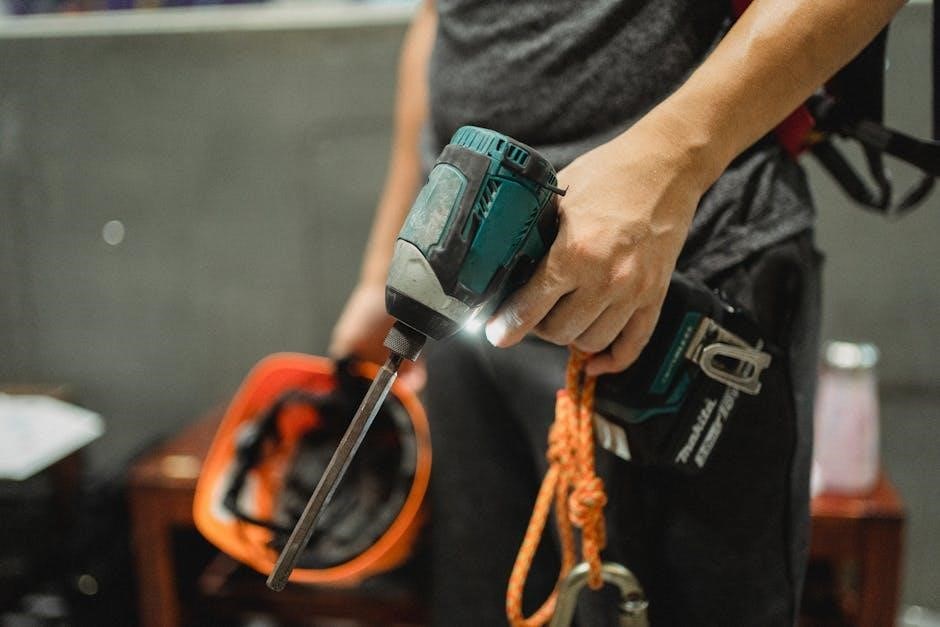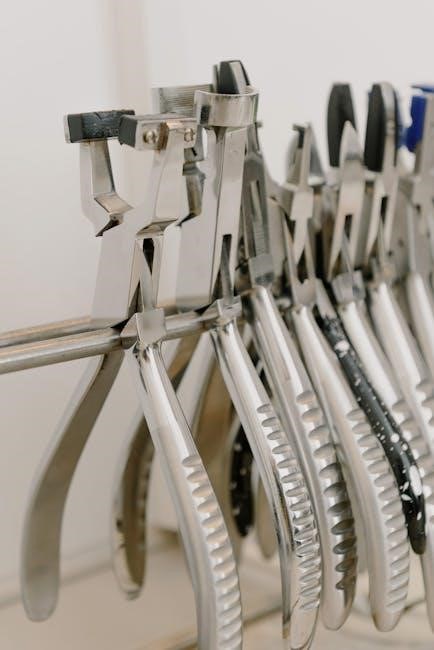This manual provides comprehensive guidelines for maintaining the Cessna 172P aircraft, covering inspections, repairs, and troubleshooting to ensure safe and efficient operation.
Purpose of the Manual
The Cessna 172P Maintenance Manual serves as a comprehensive guide for aircraft maintenance, detailing procedures for inspections, repairs, and troubleshooting. It provides essential information for ensuring compliance with aviation standards and maintaining airworthiness. This manual is designed to assist owners, mechanics, and operators in performing routine and complex maintenance tasks safely and efficiently. By following the guidelines outlined, users can ensure the aircraft remains in optimal condition for reliable operation and longevity.
Scope of the Manual
The Cessna 172P Maintenance Manual encompasses a wide range of topics, including routine inspections, servicing procedures, and detailed repair instructions. It covers essential systems such as engine maintenance, avionics, and structural components. The manual also addresses compliance with airworthiness directives and provides guidelines for documentation and record-keeping. Additionally, it includes troubleshooting techniques and diagnostic methods to address common issues. This comprehensive resource ensures that all aspects of aircraft maintenance are thoroughly addressed, promoting safety and efficiency in aircraft operations.
Intended Audience
This manual is designed for aircraft maintenance professionals, pilots, and owners responsible for the upkeep of the Cessna 172P. It serves as a critical reference for technicians performing inspections, repairs, and routine maintenance. The manual is also useful for aviation students and enthusiasts seeking detailed technical insights. While it is comprehensive, it assumes a basic understanding of aircraft systems and maintenance practices. The content is tailored to ensure compliance with safety standards and regulatory requirements, making it an essential tool for anyone involved in the aircraft’s maintenance and operation.

General Description of the Cessna 172P Aircraft
The Cessna 172P is a single-engine, four-seat aircraft designed for flight training and personal aviation. Known for its stability and durability, it remains a popular choice worldwide.
Aircraft Overview
The Cessna 172P is a single-engine, four-seat aircraft widely used for flight training and personal aviation. Known for its stability and durability, it features a Lycoming O-320 engine. Produced between 1981 and 1986, the 172P is part of the Skyhawk series, renowned for its reliability and ease of handling. With a maximum cruising speed of 122 knots, it remains a popular choice for both novice pilots and experienced aviators. Its design emphasizes safety and performance, making it a cornerstone in general aviation.
Key Systems and Components
The Cessna 172P features a Lycoming O-320 engine, a fixed tricycle landing gear, and a Garmin G1000 avionics suite for navigation and communication. Its electrical system includes a 12-volt battery and alternator, while the fuel system has two wing tanks with a total capacity of 26.5 gallons. The aircraft also incorporates a reliable hydraulic braking system, a pressurized cabin, and a comprehensive avionics package for enhanced performance and safety. Regular maintenance of these systems is essential for optimal functionality and compliance with airworthiness standards.

Tools and Equipment Required for Maintenance
Maintenance of the Cessna 172P requires specialized tools, including wrenches, screwdrivers, and multimeters for electrical systems. Aviation-specific tools like aircraft jacks, tie-downs, and fuel testing equipment are essential. Mechanics should also have access to diagnostic software and manuals, such as the Cessna Service Manual D2065-2-13, to ensure compliance with manufacturer guidelines. Additionally, safety equipment like gloves, safety glasses, and fire extinguishers are critical for protecting both personnel and the aircraft during maintenance procedures.

Aircraft Specifications
The Cessna 172P features a Lycoming O-320 engine, producing 180 horsepower, with a maximum takeoff weight of 2,550 lbs and a fuel capacity of 38 gallons.
Performance Characteristics
The Cessna 172P delivers a cruise speed of 122 knots at 8,000 feet, with a climb rate of 720 feet per minute. Its service ceiling is 13,500 feet, and it offers a range of 795 nautical miles with optional fuel tanks. The aircraft’s performance is optimized for stability and responsiveness, making it ideal for training and personal flying. Weight and altitude conditions can affect these figures, but the 172P consistently demonstrates reliable and efficient flight characteristics, ensuring a smooth and predictable flying experience for pilots of all skill levels.
Weight and Balance Limits
The Cessna 172P has a maximum takeoff weight of 2,550 pounds, with a typical empty weight of approximately 1,600 pounds. The useful load, including fuel, passengers, and cargo, is around 950 pounds. Proper weight distribution is critical for safe operation, with specific limits for front and rear seat occupants. Exceeding these limits can compromise aircraft performance and safety. Always refer to the Pilot’s Operating Handbook (POH) for precise calculations and guidelines tailored to specific flight conditions and configurations.
Fluid Capacities and Requirements
The Cessna 172P requires specific fluid capacities to ensure optimal performance and safety. Engine oil capacity is approximately 6 quarts, while the fuel tank holds up to 26.5 gallons of avgas. Coolant systems use a 50/50 mix of ethylene glycol and water. Hydraulic fluid is essential for brake operation. Adherence to approved fluid specifications is critical for maintaining airworthiness and preventing system damage. Always consult the POH or maintenance manual for precise guidelines tailored to the aircraft’s configuration and operational conditions.

Maintenance Requirements
Routine inspections, scheduled servicing, and compliance with airworthiness directives are essential. Adherence to manufacturer guidelines ensures safety, performance, and longevity of the Cessna 172P aircraft.
Routine Maintenance Schedule
The Cessna 172P requires regular inspections and servicing to maintain airworthiness. Routine tasks include pre-flight checks, 50-hour inspections, annual inspections, and 100-hour checks. Compliance with Cessna Service Letters and airworthiness directives is mandatory. Engine oil changes, tire pressure checks, and battery maintenance are performed at specified intervals. Guidelines outline detailed procedures for lubrication, fluid replacements, and component inspections. Adhering to the schedule ensures optimal performance, safety, and compliance with aviation regulations. Proper documentation of all maintenance activities is essential for accountability and future reference.
Service Intervals
Service intervals for the Cessna 172P are designed to ensure ongoing airworthiness and safety. Routine inspections are required at 50-hour and 100-hour intervals, while annual inspections are mandatory. Engine oil changes are typically performed every 50 hours, and tire pressures must be checked and adjusted regularly. Compliance with Cessna Service Letters, such as SE73-25, is critical for maintaining aircraft integrity. Proper documentation of all services ensures adherence to aviation regulations and extends the lifespan of the aircraft. Regular maintenance intervals help prevent unexpected issues and ensure reliable performance.
Record-Keeping and Documentation
Accurate and detailed record-keeping is essential for maintaining compliance and tracking the Cessna 172P’s maintenance history. All service activities, inspections, and repairs must be documented in the aircraft’s maintenance logs. Service Letters, such as SE73-25, must be referenced and noted. Records should include dates, details of work performed, and the technician’s certification. Proper documentation ensures traceability of parts and compliance with aviation regulations. Maintaining complete and organized records also supports efficient future maintenance and enhances aircraft value. Always refer to the latest Cessna Service Manual for specific documentation requirements.

Inspections
Regular inspections are critical for ensuring the Cessna 172P’s safety and compliance with aviation standards. They cover airworthiness checks, system evaluations, and compliance with Service Letters and Directives.
Pre-Flight Inspection Checklist
The pre-flight inspection checklist for the Cessna 172P ensures all systems are operational and safe for flight. Exterior checks include verifying control surfaces, tires, and fluid levels. Interior checks involve testing avionics, lights, and flight instruments. Compliance with Service Letters and Airworthiness Directives is mandatory. Proper documentation and adherence to maintenance schedules are emphasized to maintain airworthiness and safety standards.
Periodic Inspections
Periodic inspections are essential for maintaining the Cessna 172P’s airworthiness. These include routine checks of the engine, propeller, control surfaces, and avionics systems. Inspections must comply with Service Letters and Airworthiness Directives. Detailed procedures are outlined in the Service Manual, ensuring all components meet safety standards. Regular maintenance intervals, such as the 50-hour and annual inspections, are critical for identifying and addressing potential issues before they affect flight safety. Adherence to these schedules ensures optimal performance and compliance with aviation regulations.
Annual Inspection Requirements
The annual inspection is a detailed, thorough review of the Cessna 172P aircraft, ensuring compliance with airworthiness standards. It includes a comprehensive check of all systems, including engine, electrical, fuel, and hydraulic components. Structural integrity, control surfaces, and avionics are also inspected. All findings must be documented, and any discrepancies addressed. The inspection must be performed by a qualified mechanic and comply with Service Letters and Airworthiness Directives. Completion of the annual inspection ensures the aircraft is safe for operation and meets regulatory requirements. The maintenance log must be updated and signed off.

Common Repairs and Modifications
Common repairs include engine maintenance, avionics upgrades, and structural inspections. Modifications often involve upgrading navigation systems or installing performance-enhancing components, ensuring compliance with service letters and airworthiness directives.
Engine Maintenance and Repair
Engine maintenance for the Cessna 172P involves routine inspections, oil changes, and compliance with service letters. Repair procedures include replacing worn components like piston rings or cylinders. Regular lubrication and filter replacements are essential to prevent premature wear. Troubleshooting engine issues often requires consulting the service manual for specific diagnostic steps. Proper documentation of all maintenance activities is critical to ensure airworthiness and compliance with aviation regulations. Always refer to the Cessna 172P Service Manual for detailed procedures and guidelines.
Avionics Upgrades and Troubleshooting
Avionics upgrades for the Cessna 172P may include installing modern navigation or communication systems. Troubleshooting involves diagnosing issues like faulty sensors or software glitches. Refer to the avionics service manual for specific procedures. Regular checks ensure compliance with federal aviation regulations. Upgrades must be performed by certified technicians to maintain airworthiness. Proper documentation of all modifications is required. Always follow manufacturer guidelines for installation and testing to ensure system reliability and safety.
Structural Repairs and Modifications
Structural repairs on the Cessna 172P require precise adherence to manufacturer specifications. Common modifications include strengthening parts or upgrading components for enhanced durability. Corrosion prevention is critical, especially in high-moisture areas. Repairs must be documented and approved by aviation authorities. Always refer to the structural repair manual (e;g., Cessna document D2065-2-13) for detailed procedures. Proper tools and materials ensure compliance with safety standards. Regular inspections help identify potential issues early, preventing costly damages.

Troubleshooting
Troubleshooting involves diagnosing issues using diagnostic techniques, addressing common problems, and ensuring compliance with airworthiness directives to maintain aircraft safety and performance standards.
Common Issues and Solutions
Common issues with the Cessna 172P include engine oil leaks, avionics malfunctions, and wear on landing gear components. Solutions involve routine inspections, adherence to service manuals, and timely replacement of worn parts; Proper troubleshooting techniques, as outlined in the manual, help identify root causes. Compliance with airworthiness directives ensures all repairs meet safety standards. Regular maintenance, such as checking fluid levels and electrical systems, prevents recurring problems. Referencing the service manual and Cessna-issued service letters provides detailed repair procedures for optimal aircraft performance and longevity.
Diagnostic Techniques
Diagnosing issues in the Cessna 172P involves systematic troubleshooting using factory-authorized service manuals and troubleshooting guides. Visual inspections, functional tests, and specialized tools help identify faults. Pilots and mechanics should follow structured checklists to isolate problems, such as engine malfunctions or avionics glitches. Regular use of test equipment ensures accurate diagnoses. Compliance with Cessna-issued service letters and bulletins is crucial for addressing known issues. Proper documentation of findings aids in maintaining airworthiness and ensures repairs align with manufacturer guidelines, promoting safety and reliability.
Compliance with Airworthiness Directives
Adhering to airworthiness directives is critical for maintaining the Cessna 172P’s safety and regulatory compliance. Mechanics must refer to the latest directives issued by aviation authorities, ensuring all mandatory modifications and inspections are completed. Service Manual D2065-2-13 and related bulletins provide specific guidance. Compliance must be documented in maintenance records, with repairs performed by certified professionals. Non-compliance can lead to operational restrictions, highlighting the importance of strict adherence to these directives for continued airworthiness and legal flight operations.

Safety Precautions
Adhere to safety guidelines, use protective equipment, and follow manual instructions. Regular training and updates ensure compliance with aviation standards.
General Safety Guidelines
Adhere to all safety protocols outlined in the manual to minimize risks during maintenance. Always wear protective gear, including gloves and eyewear. Ensure proper ventilation when handling hazardous materials and follow fire safety precautions. Use approved tools and equipment, and never bypass safety mechanisms. Secure the aircraft properly before starting work, and ensure all systems are de-energized. Familiarize yourself with emergency procedures and maintain a clean, organized workspace. Regularly inspect equipment and report any defects. Stay updated on safety best practices and comply with aviation regulations to ensure a safe working environment.
Hazardous Materials Handling
Properly manage hazardous materials such as fuels, oils, and chemicals during maintenance. Follow all safety data sheets (SDS) for handling, storage, and disposal. Use appropriate personal protective equipment (PPE) to prevent exposure. Ensure adequate ventilation in work areas to avoid inhalation risks. Store materials in approved containers and keep them away from ignition sources. Dispose of waste materials according to environmental regulations and company policies. Never mix incompatible substances, and label all containers clearly. Training on hazardous materials handling is essential for all personnel involved in maintenance activities to ensure compliance and safety.
Emergency Procedures
In case of emergencies during maintenance, such as fire or system failure, evacuate the area immediately and alert nearby personnel. Use fire extinguishers rated for aviation fuels and electrical fires. Isolate power sources and disable systems to prevent further damage. Document all incidents and conduct a thorough inspection before resuming work. Follow established protocols for reporting incidents to ensure safety and compliance with aviation regulations. Always prioritize personal safety and use emergency communication devices if necessary. Regular training on emergency procedures is crucial for all maintenance personnel.
Environmental Considerations
Environmental considerations in Cessna 172P maintenance involve adhering to regulations and using eco-friendly practices. Proper disposal of fuels, oils, and chemicals is essential to prevent contamination. Minimize hazardous material use and employ noise reduction techniques. Regular training ensures environmental compliance and sustainable operations, promoting aviation’s role in conservation and responsible resource management.
Waste Disposal and Recycling
Proper waste disposal and recycling are critical in Cessna 172P maintenance. Dispose of hazardous materials like fuels, oils, and chemicals according to local and federal regulations. Implement recycling programs for metals, plastics, and other reusable materials. Ensure all waste is handled by authorized facilities to minimize environmental impact. Regular training on waste management practices is essential for compliance and sustainability in aviation maintenance operations.
Noise Reduction Practices
Noise reduction practices for the Cessna 172P involve regular maintenance to minimize operational noise. Ensure proper lubrication of moving parts, inspect and replace worn components, and maintain proper engine tuning. Use noise-reducing materials for interior and exterior components. Adhere to manufacturer guidelines for muffler and exhaust system maintenance. Conduct ground runs in designated areas to reduce noise impact on surrounding environments. Follow local noise abatement procedures during takeoff and landing to comply with aviation regulations and community standards.
Compliance with Aviation Regulations
Compliance with aviation regulations is essential for ensuring the airworthiness and safe operation of the Cessna 172P. Adhere to Federal Aviation Regulations (FARs) and guidelines set by aviation authorities. Regularly review and implement updates from service letters, bulletins, and airworthiness directives. Maintain detailed records of all maintenance activities to demonstrate compliance. Ensure all repairs and modifications meet approved standards. Familiarize yourself with local aviation laws and international standards when operating outside your home country. Compliance ensures operational safety and avoids legal penalties.
Documentation and Reporting
Accurate documentation and reporting are critical for maintaining compliance and tracking the Cessna 172P’s maintenance history. Keep detailed records of all inspections, repairs, and servicing in the aircraft logbooks. Ensure work orders include dates, times, and technician signatures. Maintain copies of service manuals, parts catalogs, and airworthiness directives. Submit reports to aviation authorities as required, detailing any significant repairs or modifications. Proper documentation ensures transparency, accountability, and adherence to safety standards, while also aiding in future maintenance planning and compliance checks.
Maintenance Log Requirements
Maintenance logs must be meticulously maintained for the Cessna 172P, documenting all performed tasks, inspections, and repairs. Each entry should include the date, technician’s signature, and details of work completed. Logs must comply with aviation regulations and include references to applicable service manuals and airworthiness directives. Accurate record-keeping ensures traceability and accountability, while also providing a clear history for future maintenance planning. Regular audits of logs are essential to verify compliance and maintain the aircraft’s airworthiness certification.
Training and Certification
Technicians must complete certified training programs approved by aviation authorities to work on the Cessna 172P. These programs cover airframe, powerplant, and avionics systems. Certification requires passing exams and demonstrating practical skills. Recertification is mandatory to stay updated on new regulations and technologies. Training often includes courses on specific Cessna systems and reference to original service manuals. Manufacturer-approved workshops and online resources are recommended for continuous learning and compliance with industry standards.
Continuous Improvement Practices
Continuous improvement practices ensure the Cessna 172P maintenance process remains efficient and aligned with industry standards. Regularly reviewing and updating procedures based on manufacturer service letters and bulletins is essential. Technicians should document and share feedback to refine workflows and address recurring issues. Implementing lean maintenance practices and staying updated with the latest tools and technologies further enhances effectiveness. Collaboration with Cessna support networks and participation in industry forums also contribute to ongoing improvement in maintenance quality and compliance.
Customer Support and Resources
The Cessna 172P maintenance process is supported by extensive resources, including official service manuals, parts catalogs, and technical documentation. Cessna dealers provide updated service letters and bulletins to ensure compliance and efficiency. Online forums and aviation communities offer additional guidance and troubleshooting tips. Manufacturers and authorized distributors supply genuine parts and tools, while customer care directories and support networks are available for assistance. These resources ensure technicians and owners have access to reliable information for optimal aircraft maintenance and operation.

Warranty and Service Programs
The Cessna 172P is supported by warranty programs covering parts and labor for specific components. Authorized service centers provide repairs under warranty, ensuring compliance with manufacturer standards. Extended service programs are available for enhanced maintenance coverage. These programs include access to genuine parts, technical support, and regular inspections. Warranty terms vary by component, with detailed information provided in the official service manual. Proper documentation and adherence to maintenance schedules are required to maintain warranty validity and ensure optimal aircraft performance and safety.
Online Resources and Forums
Various online platforms offer valuable resources for Cessna 172P maintenance, including forums, PDF manuals, and technical guides. Websites provide access to service bulletins, parts catalogs, and troubleshooting tips. Pilots and mechanics share experiences and solutions, fostering a collaborative environment. These resources supplement the official manual, offering real-world insights and best practices. They are essential for staying updated on maintenance procedures and resolving issues efficiently.
Industry Standards and Best Practices
Adherence to industry standards ensures the Cessna 172P is maintained safely and efficiently. Compliance with FAA regulations and reference to Cessna-authorized manuals are critical. Standardized tools and techniques, as outlined in service letters, must be followed. Regular training for mechanics and documentation of all procedures are essential. Environmental practices, such as proper waste disposal, align with global aviation standards. These practices ensure reliability, safety, and compliance, reflecting the highest maintenance benchmarks for the aircraft.
Future Updates and Revisions
The Cessna 172P maintenance manual undergoes periodic updates to reflect new standards, service letters, and technical advancements. Users are advised to subscribe to Cessna’s official updates and bulletins for the latest revisions. Digital versions of the manual may include automated notifications for changes. Regular reviews ensure compliance with evolving aviation regulations. Staying informed about updates is crucial for maintaining safety and operational efficiency. Always refer to the most recent version for accurate and compliant maintenance practices.
The Cessna 172P maintenance manual serves as an essential resource for ensuring the aircraft’s safety, performance, and longevity. By adhering to the guidelines outlined, operators can maintain compliance with aviation standards and optimize their maintenance routines. Regular updates and revisions ensure the manual remains relevant and accurate. Users are encouraged to utilize Cessna’s official support network for additional resources and assistance. Proper maintenance practices, as detailed in this manual, are critical for preserving the aircraft’s operational integrity and ensuring continued safe flight operations.